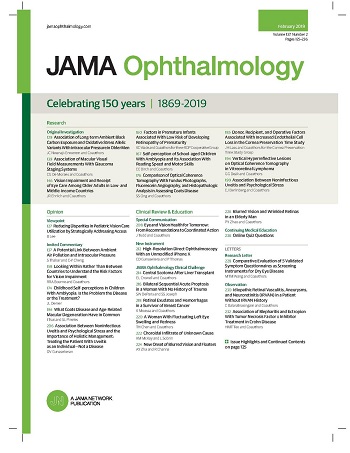台湾儿童局部使用阿托品之眼部风险。
IF 9.2
1区 医学
Q1 OPHTHALMOLOGY
引用次数: 0
摘要
近视是一个全球性的健康问题,高度近视会增加眼部并发症的风险。虽然阿托品可以影响近视进展,但其长期安全性仍不确定。目的探讨台湾儿童处方阿托品控制近视的眼部危险因素。研究对象包括2001年至2015年期间新诊断为近视的8至15岁儿童和匹配的非近视对照参与者。数据分析时间为2024年3月8日至5月30日。研究人员收集了阿托品处方的数据,并根据累积持续时间和剂量对参与者进行了分类。观察期间记录白内障、原发性开角型青光眼、黄斑病变的诊断情况。在至少5年的随访期后,报告了眼部并发症的发生率。使用多变量Cox回归模型得出风险比(hr),以评估阿托品相关风险。结果共纳入台湾儿童1 213 846例(近视诊断时平均[SD]年龄10.4[1.9]岁;女性633 440例(52.2%))。606 923例近视儿童中,406 383例(67.0%)使用阿托品。眼部并发症(白内障、青光眼和黄斑病变)的发生率在近视组(1.54 / 10 000人年)高于非近视组(0.96 / 10 000人年;校正HR [aHR]为1.49;95% CI为1.36-1.64)。在近视儿童中,阿托品服用者和非服用者的眼部并发症发生率无差异(均为1.54 / 10 000人年;aHR, 1.05; 95% CI, 0.93-1.18)。阿托品处方累计持续时间超过3年的儿童眼部并发症风险增加(aHR, 1.51; 95% CI, 1.17-1.94)。然而,这种趋势在高度近视儿童中不存在(aHR, 1.10; 95% CI, 0.56-2.19)。在阿托品累积剂量最高的四分位数儿童中,未发现风险增加(aHR, 1.05; 95% CI, 0.89-1.25)。结论和相关性虽然近视儿童白内障、青光眼或黄斑病变的发病率较高,但阿托品处方与这些风险无关。虽然这些发现为权衡使用阿托品控制近视的风险和益处提供了见解,但它们仅限于阿托品处方暗示使用阿托品,并且它们产生了假设,但不能暗示因果关系。本文章由计算机程序翻译,如有差异,请以英文原文为准。
Ocular Risks of Topical Atropine Prescriptions Among Taiwanese Children.
Importance
Myopia is a global health concern, with high myopia elevating the risk of ocular complications. While atropine can affect myopia progression, its long-term safety profile remains uncertain.
Objective
To investigate the ocular risks associated with atropine prescription in clinical practice for myopia control in Taiwanese children.
Design, Setting, and Participants
This was a retrospective, population-based cohort study using longitudinal data from Taiwan's National Health Insurance Research Database (2000-2021). Children aged 8 to 15 years with newly diagnosed myopia and matched nonmyopic control participants in the period between 2001 and 2015 were included. Data analysis was performed from March 8 to May 30, 2024.
Exposure
Data on atropine prescription were collected, and participants were categorized by cumulative duration and dose.
Main Outcomes and Measures
Diagnoses of cataracts, primary open-angle glaucoma, and maculopathy were recorded during the observation period. The incidence of ocular complications after a minimum 5-year follow-up period was reported. Hazard ratios (HRs) were derived using multivariable Cox regression models to evaluate atropine-related risks.
Results
A total of 1 213 846 Taiwanese children (mean [SD] age at myopia diagnosis, 10.4 [1.9] years; 633 440 [52.2%] female) were included. Among 606 923 children with myopia, 406 383 (67.0%) were prescribed atropine. The incidence of ocular complications (cataracts, glaucoma, and maculopathy) was higher in the myopia group (1.54 per 10 000 person-years) compared with the nonmyopia group (0.96 per 10 000 person-years; adjusted HR [aHR], 1.49; 95% CI, 1.36-1.64). In children with myopia, the incidence of ocular complications was not different between atropine users and nonusers (both 1.54 per 10 000 person-year; aHR, 1.05; 95% CI, 0.93-1.18). An increased risk of ocular complications was observed in children with cumulative duration of atropine prescription exceeding 3 years (aHR, 1.51; 95% CI, 1.17-1.94). However, this trend was not present when conditioned on children with high myopia (aHR, 1.10; 95% CI, 0.56-2.19). No increased risk was found among children with the highest quartile of cumulative atropine dose (aHR, 1.05; 95% CI, 0.89-1.25).
Conclusions and Relevance
While the incidence of cataracts, glaucoma, or maculopathy was higher in children with myopia, atropine prescription was not associated with these risks. While these findings offer insights for weighing risks and benefits of atropine use in myopia control, they are limited to atropine prescriptions implying atropine use, and they generate hypotheses but cannot imply cause-and-effect relationships.
求助全文
通过发布文献求助,成功后即可免费获取论文全文。
去求助
来源期刊

JAMA ophthalmology
OPHTHALMOLOGY-
CiteScore
13.20
自引率
3.70%
发文量
340
期刊介绍:
JAMA Ophthalmology, with a rich history of continuous publication since 1869, stands as a distinguished international, peer-reviewed journal dedicated to ophthalmology and visual science. In 2019, the journal proudly commemorated 150 years of uninterrupted service to the field. As a member of the esteemed JAMA Network, a consortium renowned for its peer-reviewed general medical and specialty publications, JAMA Ophthalmology upholds the highest standards of excellence in disseminating cutting-edge research and insights. Join us in celebrating our legacy and advancing the frontiers of ophthalmology and visual science.
 求助内容:
求助内容: 应助结果提醒方式:
应助结果提醒方式:


